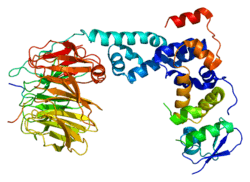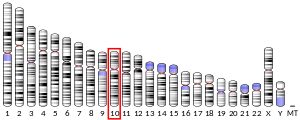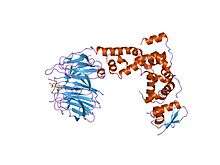BTRC (gene)
F-box/WD repeat-containing protein 1A (FBXW1A) also known as βTrCP1 or Fbxw1 or hsSlimb or pIkappaBalpha-E3 receptor subunit is a protein that in humans is encoded by the BTRC (beta-transducin repeat containing) gene.[5][6]
This gene encodes a member of the F-box protein family which is characterized by an approximately 40 residue structural motif, the F-box. The F-box proteins constitute one of the four subunits of ubiquitin protein ligase complex called SCFs (Skp1-Cul1-F-box protein), which often, but not always, recognize substrates in a phosphorylation-dependent manner. F-box proteins are divided into 3 classes:
- Fbxws containing WD40 repeats,
- Fbxls containing leucine-rich repeats,
- and Fbxos containing either "other" protein–protein interaction modules or no recognizable motifs.
The protein encoded by this gene belongs to the Fbxw class as, in addition to an F-box, this protein contains multiple WD40 repeats. This protein is homologous to Xenopus βTrCP, yeast Met30, Neurospora Scon2 and Drosophila Slimb. In mammals, in addition to βTrCP1, a paralog protein (called βTrCP2 or FBXW11) also exists, but, so far, their functions appear redundant and indistinguishable.
Discovery
Human βTrCP (referred to both βTrCP1 and βTrCP2) was originally identified as a cellular ubiquitin ligase that is bound by the HIV-1 Vpu viral protein to eliminate cellular CD4 by connecting it to the proteolytic machinery.[7] Subsequently, βTrCP was shown to regulate multiple cellular processes by mediating the degradation of various targets.[8] Cell cycle regulators constitute a major group of βTrCP substrates. During S phase, βTrCP keeps CDK1 in check by promoting the degradation of the phosphatase CDC25A,[9] whereas in G2, βTrCP contributes to CDK1 activation by targeting the kinase WEE1 for degradation.[10] In early mitosis, βTrCP mediates the degradation of EMI1,[11][12] an inhibitor of the APC/C ubiquitin ligase complex, which is responsible for the anaphase-metaphase transition (by inducing the proteolysis of Securin) and mitotic exit (by driving the degradation of mitotic CDK1 activating cyclin subunits). Furthermore, βTrCP controls APC/C by targeting REST, thereby removing its transcriptional repression on MAD2, an essential component of the spindle assembly checkpoint that keeps APC/C inactive until all chromatids are attached to the spindle microtubles.[13]
Function
βTrCP plays important roles in regulating cell cycle checkpoints. In response to genotoxic stress, it contributes to turn off CDK1 activity by mediating the degradation of CDC25A in collaboration with Chk1,[9][14] thereby preventing cell cycle progression before the completion of DNA repair. During recovery from DNA replication and DNA damage, βTrCP instead targets Claspin in a Plk1-dependent manner.[15][16][17]
βTrCP has also emerged as an important player in protein translation, cell growth and survival. In response to mitogens, PDCD4, an inhibitor of the translation initiation factor eIF4A, is rapidly degraded in a βTrCP- and S6K1-dependent manner, allowing efficient protein translation and cell growth.[18] Another target of βTrCP that is involved in protein translation is eEF2K, which inhibits translation elongation by phosphorylating eukaryotic Elongation Factor 2 (eEF2) and decreasing its affinity for the ribosome.[19] βTrCP also cooperates with mTOR and CK1α to induce the degradation of DEPTOR (an mTOR inhibitor), thereby generating an auto-amplification loop to promote the full activation of mTOR.[20][21][22] At the same time, βTrCP mediates the degradation of the pro-apoptotic protein BimEL to promote cell survival.[23]
βTrCP also associates with phosphorylated IkappaBalpha and beta-catenin destruction motifs, probably functioning in multiple transcriptional programs by regulating the NF-kappaB and the WNT pathways.[24][25] βTrCP has also been shown to regulate centriole disengagement and licensing. βTrCP target the intercentrosomal linker protein Cep68 in prometaphase, which contributes to centriole disengagement and subsequent centriole separation.[26]
Clinical Significance
βTrCP behaves as an oncoprotein in some tissues. Elevated levels of βTrCP expression have been found in colorectal,[39] pancreatic,[40] hapatoblastoma,[41] and breast cancers.[42]
References
- GRCh38: Ensembl release 89: ENSG00000166167 - Ensembl, May 2017
- GRCm38: Ensembl release 89: ENSMUSG00000025217 - Ensembl, May 2017
- "Human PubMed Reference:". National Center for Biotechnology Information, U.S. National Library of Medicine.
- "Mouse PubMed Reference:". National Center for Biotechnology Information, U.S. National Library of Medicine.
- Fujiwara T, Suzuki M, Tanigami A, Ikenoue T, Omata M, Chiba T, Tanaka K (May 1999). "The BTRC gene, encoding a human F-box/WD40-repeat protein, maps to chromosome 10q24-q25". Genomics. 58 (1): 104–5. doi:10.1006/geno.1999.5792. PMID 10331953.
- "Entrez Gene: BTRC beta-transducin repeat containing".
- Margottin F, Bour SP, Durand H, Selig L, Benichou S, Richard V, Thomas D, Strebel K, Benarous R (March 1998). "A novel human WD protein, h-beta TrCp, that interacts with HIV-1 Vpu connects CD4 to the ER degradation pathway through an F-box motif". Molecular Cell. 1 (4): 565–74. doi:10.1016/S1097-2765(00)80056-8. PMID 9660940.
- Frescas D, Pagano M (June 2008). "Deregulated proteolysis by the F-box proteins SKP2 and beta-TrCP: tipping the scales of cancer". Nature Reviews. Cancer. 8 (6): 438–49. doi:10.1038/nrc2396. PMC 2711846. PMID 18500245.
- Busino L, Donzelli M, Chiesa M, Guardavaccaro D, Ganoth D, Dorrello NV, Hershko A, Pagano M, Draetta GF (November 2003). "Degradation of Cdc25A by beta-TrCP during S phase and in response to DNA damage". Nature. 426 (6962): 87–91. Bibcode:2003Natur.426...87B. doi:10.1038/nature02082. PMID 14603323.
- Watanabe N, Arai H, Nishihara Y, Taniguchi M, Watanabe N, Hunter T, Osada H (March 2004). "M-phase kinases induce phospho-dependent ubiquitination of somatic Wee1 by SCFbeta-TrCP". Proceedings of the National Academy of Sciences of the United States of America. 101 (13): 4419–24. Bibcode:2004PNAS..101.4419W. doi:10.1073/pnas.0307700101. PMC 384762. PMID 15070733.
- Guardavaccaro D, Kudo Y, Boulaire J, Barchi M, Busino L, Donzelli M, Margottin-Goguet F, Jackson PK, Yamasaki L, Pagano M (June 2003). "Control of meiotic and mitotic progression by the F box protein beta-Trcp1 in vivo". Developmental Cell. 4 (6): 799–812. doi:10.1016/S1534-5807(03)00154-0. PMID 12791266.
- Margottin-Goguet F, Hsu JY, Loktev A, Hsieh HM, Reimann JD, Jackson PK (June 2003). "Prophase destruction of Emi1 by the SCF(betaTrCP/Slimb) ubiquitin ligase activates the anaphase promoting complex to allow progression beyond prometaphase". Developmental Cell. 4 (6): 813–26. doi:10.1016/S1534-5807(03)00153-9. PMID 12791267.
- Guardavaccaro D, Frescas D, Dorrello NV, Peschiaroli A, Multani AS, Cardozo T, Lasorella A, Iavarone A, Chang S, Hernando E, Pagano M (March 2008). "Control of chromosome stability by the beta-TrCP-REST-Mad2 axis". Nature. 452 (7185): 365–9. Bibcode:2008Natur.452..365G. doi:10.1038/nature06641. PMC 2707768. PMID 18354482.
- Jin J, Shirogane T, Xu L, Nalepa G, Qin J, Elledge SJ, Harper JW (December 2003). "SCFbeta-TRCP links Chk1 signaling to degradation of the Cdc25A protein phosphatase". Genes & Development. 17 (24): 3062–74. doi:10.1101/gad.1157503. PMC 305258. PMID 14681206.
- Peschiaroli A, Dorrello NV, Guardavaccaro D, Venere M, Halazonetis T, Sherman NE, Pagano M (August 2006). "SCFbetaTrCP-mediated degradation of Claspin regulates recovery from the DNA replication checkpoint response". Molecular Cell. 23 (3): 319–29. doi:10.1016/j.molcel.2006.06.013. PMID 16885022.
- Mailand N, Bekker-Jensen S, Bartek J, Lukas J (August 2006). "Destruction of Claspin by SCFbetaTrCP restrains Chk1 activation and facilitates recovery from genotoxic stress". Molecular Cell. 23 (3): 307–18. doi:10.1016/j.molcel.2006.06.016. PMID 16885021.
- Mamely I, van Vugt MA, Smits VA, Semple JI, Lemmens B, Perrakis A, Medema RH, Freire R (October 2006). "Polo-like kinase-1 controls proteasome-dependent degradation of Claspin during checkpoint recovery". Current Biology. 16 (19): 1950–5. doi:10.1016/j.cub.2006.08.026. PMID 16934469.
- Dorrello NV, Peschiaroli A, Guardavaccaro D, Colburn NH, Sherman NE, Pagano M (October 2006). "S6K1- and betaTRCP-mediated degradation of PDCD4 promotes protein translation and cell growth". Science. 314 (5798): 467–71. Bibcode:2006Sci...314..467D. doi:10.1126/science.1130276. PMID 17053147.
- Sci Signal. 2012 Jun 5;5(227):ra40. doi: 10.1126/scisignal.2002718. SCFβTrCP-mediated degradation of eEF2K couples protein synthesis elongation to the G2 DNA damage checkpoint. Kruiswijk F., Yuniati L., Magliozzi R., Bolder R., Lim R., Low T., Heck A., Pagano M., and Guardavaccaro D.
- Duan S, Skaar JR, Kuchay S, Toschi A, Kanarek N, Ben-Neriah Y, Pagano M (October 2011). "mTOR generates an auto-amplification loop by triggering the βTrCP- and CK1α-dependent degradation of DEPTOR". Molecular Cell. 44 (2): 317–24. doi:10.1016/j.molcel.2011.09.005. PMC 3212871. PMID 22017877.
- Zhao Y, Xiong X, Sun Y (October 2011). "DEPTOR, an mTOR inhibitor, is a physiological substrate of SCF(βTrCP) E3 ubiquitin ligase and regulates survival and autophagy". Molecular Cell. 44 (2): 304–16. doi:10.1016/j.molcel.2011.08.029. PMC 3216641. PMID 22017876.
- Gao D, Inuzuka H, Tan MK, Fukushima H, Locasale JW, Liu P, Wan L, Zhai B, Chin YR, Shaik S, Lyssiotis CA, Gygi SP, Toker A, Cantley LC, Asara JM, Harper JW, Wei W (October 2011). "mTOR drives its own activation via SCF(βTrCP)-dependent degradation of the mTOR inhibitor DEPTOR". Molecular Cell. 44 (2): 290–303. doi:10.1016/j.molcel.2011.08.030. PMC 3229299. PMID 22017875.
- Dehan E, Bassermann F, Guardavaccaro D, Vasiliver-Shamis G, Cohen M, Lowes KN, Dustin M, Huang DC, Taunton J, Pagano M (January 2009). "betaTrCP- and Rsk1/2-mediated degradation of BimEL inhibits apoptosis". Molecular Cell. 33 (1): 109–16. doi:10.1016/j.molcel.2008.12.020. PMC 2655121. PMID 19150432.
- Winston JT, Strack P, Beer-Romero P, Chu CY, Elledge SJ, Harper JW (February 1999). "The SCFbeta-TRCP-ubiquitin ligase complex associates specifically with phosphorylated destruction motifs in IkappaBalpha and beta-catenin and stimulates IkappaBalpha ubiquitination in vitro". Genes & Development. 13 (3): 270–83. doi:10.1101/gad.13.3.270. PMC 316433. PMID 9990852.
- Latres E, Chiaur DS, Pagano M (January 1999). "The human F box protein beta-Trcp associates with the Cul1/Skp1 complex and regulates the stability of beta-catenin". Oncogene. 18 (4): 849–54. doi:10.1038/sj.onc.1202653. PMID 10023660.
- Nature cell biology. 2015;17(1):31-43. doi:10.1038/ncb3076. Degradation of Cep68 and PCNT cleavage mediate Cep215 removal from the PCM to allow centriole separation, disengagement and licensing. Pagan JK, Marzio A, Jones MJ, Saraf A, Jallepalli PV, Florens L, Washburn MP, Pagano M.
- Liu C, Kato Y, Zhang Z, Do VM, Yankner BA, He X (May 1999). "beta-Trcp couples beta-catenin phosphorylation-degradation and regulates Xenopus axis formation". Proceedings of the National Academy of Sciences of the United States of America. 96 (11): 6273–8. doi:10.1073/pnas.96.11.6273. PMC 26871. PMID 10339577.
- Cenciarelli C, Chiaur DS, Guardavaccaro D, Parks W, Vidal M, Pagano M (October 1999). "Identification of a family of human F-box proteins". Current Biology. 9 (20): 1177–9. doi:10.1016/S0960-9822(00)80020-2. PMID 10531035.
- Semplici F, Meggio F, Pinna LA, Oliviero S (June 2002). "CK2-dependent phosphorylation of the E2 ubiquitin conjugating enzyme UBC3B induces its interaction with beta-TrCP and enhances beta-catenin degradation". Oncogene. 21 (25): 3978–87. doi:10.1038/sj.onc.1205574. PMID 12037680.
- Suzuki H, Chiba T, Suzuki T, Fujita T, Ikenoue T, Omata M, Furuichi K, Shikama H, Tanaka K (January 2000). "Homodimer of two F-box proteins betaTrCP1 or betaTrCP2 binds to IkappaBalpha for signal-dependent ubiquitination". The Journal of Biological Chemistry. 275 (4): 2877–84. doi:10.1074/jbc.275.4.2877. PMID 10644755.
- Min KW, Hwang JW, Lee JS, Park Y, Tamura TA, Yoon JB (May 2003). "TIP120A associates with cullins and modulates ubiquitin ligase activity". The Journal of Biological Chemistry. 278 (18): 15905–10. doi:10.1074/jbc.M213070200. PMID 12609982.
- Mantovani F, Banks L (October 2003). "Regulation of the discs large tumor suppressor by a phosphorylation-dependent interaction with the beta-TrCP ubiquitin ligase receptor". The Journal of Biological Chemistry. 278 (43): 42477–86. doi:10.1074/jbc.M302799200. PMID 12902344.
- Spencer E, Jiang J, Chen ZJ (February 1999). "Signal-induced ubiquitination of IkappaBalpha by the F-box protein Slimb/beta-TrCP". Genes & Development. 13 (3): 284–94. doi:10.1101/gad.13.3.284. PMC 316434. PMID 9990853.
- Fong A, Sun SC (June 2002). "Genetic evidence for the essential role of beta-transducin repeat-containing protein in the inducible processing of NF-kappa B2/p100". The Journal of Biological Chemistry. 277 (25): 22111–4. doi:10.1074/jbc.C200151200. PMID 11994270.
- Vatsyayan J, Qing G, Xiao G, Hu J (September 2008). "SUMO1 modification of NF-kappaB2/p100 is essential for stimuli-induced p100 phosphorylation and processing". EMBO Reports. 9 (9): 885–90. doi:10.1038/embor.2008.122. PMC 2529344. PMID 18617892.
- Westbrook TF, Hu G, Ang XL, Mulligan P, Pavlova NN, Liang A, Leng Y, Maehr R, Shi Y, Harper JW, Elledge SJ (March 2008). "SCFbeta-TRCP controls oncogenic transformation and neural differentiation through REST degradation". Nature. 452 (7185): 370–4. Bibcode:2008Natur.452..370W. doi:10.1038/nature06780. PMC 2688689. PMID 18354483.
- Strack P, Caligiuri M, Pelletier M, Boisclair M, Theodoras A, Beer-Romero P, Glass S, Parsons T, Copeland RA, Auger KR, Benfield P, Brizuela L, Rolfe M (July 2000). "SCF(beta-TRCP) and phosphorylation dependent ubiquitinationof I kappa B alpha catalyzed by Ubc3 and Ubc4". Oncogene. 19 (31): 3529–36. doi:10.1038/sj.onc.1203647. PMID 10918611.
- "Molecular Interaction Database". Archived from the original on 2006-05-06. Retrieved 2012-05-08.
- Ougolkov A, Zhang B, Yamashita K, Bilim V, Mai M, Fuchs SY, Minamoto T (August 2004). "Associations among beta-TrCP, an E3 ubiquitin ligase receptor, beta-catenin, and NF-kappaB in colorectal cancer". Journal of the National Cancer Institute. 96 (15): 1161–70. doi:10.1093/jnci/djh219. PMID 15292388.
- Müerköster S, Arlt A, Sipos B, Witt M, Grossmann M, Klöppel G, Kalthoff H, Fölsch UR, Schäfer H (February 2005). "Increased expression of the E3-ubiquitin ligase receptor subunit betaTRCP1 relates to constitutive nuclear factor-kappaB activation and chemoresistance in pancreatic carcinoma cells". Cancer Research. 65 (4): 1316–24. doi:10.1158/0008-5472.CAN-04-1626. PMID 15735017.
- Koch A, Waha A, Hartmann W, Hrychyk A, Schüller U, Waha A, Wharton KA, Fuchs SY, von Schweinitz D, Pietsch T (June 2005). "Elevated expression of Wnt antagonists is a common event in hepatoblastomas". Clinical Cancer Research. 11 (12): 4295–304. doi:10.1158/1078-0432.CCR-04-1162. PMID 15958610.
- Spiegelman VS, Tang W, Chan AM, Igarashi M, Aaronson SA, Sassoon DA, Katoh M, Slaga TJ, Fuchs SY (September 2002). "Induction of homologue of Slimb ubiquitin ligase receptor by mitogen signaling". The Journal of Biological Chemistry. 277 (39): 36624–30. doi:10.1074/jbc.M204524200. PMID 12151397.
External links
- Human BTRC genome location and BTRC gene details page in the UCSC Genome Browser.
Further reading
- Westbrook TF, Hu G, Ang XL, Mulligan P, Pavlova NN, Liang A, Leng Y, Maehr R, Shi Y, Harper JW, Elledge SJ (March 2008). "SCFbeta-TRCP controls oncogenic transformation and neural differentiation through REST degradation". Nature. 452 (7185): 370–4. Bibcode:2008Natur.452..370W. doi:10.1038/nature06780. PMC 2688689. PMID 18354483.
- Maniatis T (March 1999). "A ubiquitin ligase complex essential for the NF-kappaB, Wnt/Wingless, and Hedgehog signaling pathways". Genes & Development. 13 (5): 505–10. doi:10.1101/gad.13.5.505. PMID 10072378.
- Li L, Li HS, Pauza CD, Bukrinsky M, Zhao RY (2006). "Roles of HIV-1 auxiliary proteins in viral pathogenesis and host-pathogen interactions". Cell Research. 15 (11–12): 923–34. doi:10.1038/sj.cr.7290370. PMID 16354571.
- Bonaldo MF, Lennon G, Soares MB (September 1996). "Normalization and subtraction: two approaches to facilitate gene discovery". Genome Research. 6 (9): 791–806. doi:10.1101/gr.6.9.791. PMID 8889548.
- Yaron A, Hatzubai A, Davis M, Lavon I, Amit S, Manning AM, Andersen JS, Mann M, Mercurio F, Ben-Neriah Y (December 1998). "Identification of the receptor component of the IkappaBalpha-ubiquitin ligase". Nature. 396 (6711): 590–4. doi:10.1038/25159. PMID 9859996.
- Winston JT, Strack P, Beer-Romero P, Chu CY, Elledge SJ, Harper JW (February 1999). "The SCFbeta-TRCP-ubiquitin ligase complex associates specifically with phosphorylated destruction motifs in IkappaBalpha and beta-catenin and stimulates IkappaBalpha ubiquitination in vitro". Genes & Development. 13 (3): 270–83. doi:10.1101/gad.13.3.270. PMC 316433. PMID 9990852.
- Spencer E, Jiang J, Chen ZJ (February 1999). "Signal-induced ubiquitination of IkappaBalpha by the F-box protein Slimb/beta-TrCP". Genes & Development. 13 (3): 284–94. doi:10.1101/gad.13.3.284. PMC 316434. PMID 9990853.
- Kitagawa M, Hatakeyama S, Shirane M, Matsumoto M, Ishida N, Hattori K, Nakamichi I, Kikuchi A, Nakayama K, Nakayama K (May 1999). "An F-box protein, FWD1, mediates ubiquitin-dependent proteolysis of beta-catenin". The EMBO Journal. 18 (9): 2401–10. doi:10.1093/emboj/18.9.2401. PMC 1171323. PMID 10228155.
- Wu C, Ghosh S (October 1999). "beta-TrCP mediates the signal-induced ubiquitination of IkappaBbeta". The Journal of Biological Chemistry. 274 (42): 29591–4. doi:10.1074/jbc.274.42.29591. PMID 10514424.
- Cenciarelli C, Chiaur DS, Guardavaccaro D, Parks W, Vidal M, Pagano M (October 1999). "Identification of a family of human F-box proteins". Current Biology. 9 (20): 1177–9. doi:10.1016/S0960-9822(00)80020-2. PMID 10531035.
- Stone DM, Murone M, Luoh S, Ye W, Armanini MP, Gurney A, Phillips H, Brush J, Goddard A, de Sauvage FJ, Rosenthal A (December 1999). "Characterization of the human suppressor of fused, a negative regulator of the zinc-finger transcription factor Gli". Journal of Cell Science. 112. 112 ( Pt 23): 4437–48. PMID 10564661.
- Suzuki H, Chiba T, Suzuki T, Fujita T, Ikenoue T, Omata M, Furuichi K, Shikama H, Tanaka K (January 2000). "Homodimer of two F-box proteins betaTrCP1 or betaTrCP2 binds to IkappaBalpha for signal-dependent ubiquitination". The Journal of Biological Chemistry. 275 (4): 2877–84. doi:10.1074/jbc.275.4.2877. PMID 10644755.
- Read MA, Brownell JE, Gladysheva TB, Hottelet M, Parent LA, Coggins MB, Pierce JW, Podust VN, Luo RS, Chau V, Palombella VJ (April 2000). "Nedd8 modification of cul-1 activates SCF(beta(TrCP))-dependent ubiquitination of IkappaBalpha". Molecular and Cellular Biology. 20 (7): 2326–33. doi:10.1128/MCB.20.7.2326-2333.2000. PMC 85397. PMID 10713156.
- Sadot E, Simcha I, Iwai K, Ciechanover A, Geiger B, Ben-Ze'ev A (April 2000). "Differential interaction of plakoglobin and beta-catenin with the ubiquitin-proteasome system". Oncogene. 19 (16): 1992–2001. doi:10.1038/sj.onc.1203519. PMID 10803460.
- Chiaur DS, Murthy S, Cenciarelli C, Parks W, Loda M, Inghirami G, Demetrick D, Pagano M (2000). "Five human genes encoding F-box proteins: chromosome mapping and analysis in human tumors". Cytogenetics and Cell Genetics. 88 (3–4): 255–8. doi:10.1159/000015532. PMID 10828603.
- Orian A, Gonen H, Bercovich B, Fajerman I, Eytan E, Israël A, Mercurio F, Iwai K, Schwartz AL, Ciechanover A (June 2000). "SCF(beta)(-TrCP) ubiquitin ligase-mediated processing of NF-kappaB p105 requires phosphorylation of its C-terminus by IkappaB kinase". The EMBO Journal. 19 (11): 2580–91. doi:10.1093/emboj/19.11.2580. PMC 212749. PMID 10835356.
- Strack P, Caligiuri M, Pelletier M, Boisclair M, Theodoras A, Beer-Romero P, Glass S, Parsons T, Copeland RA, Auger KR, Benfield P, Brizuela L, Rolfe M (July 2000). "SCF(beta-TRCP) and phosphorylation dependent ubiquitinationof I kappa B alpha catalyzed by Ubc3 and Ubc4". Oncogene. 19 (31): 3529–36. doi:10.1038/sj.onc.1203647. PMID 10918611.
- Kleijnen MF, Shih AH, Zhou P, Kumar S, Soccio RE, Kedersha NL, Gill G, Howley PM (August 2000). "The hPLIC proteins may provide a link between the ubiquitination machinery and the proteasome". Molecular Cell. 6 (2): 409–19. doi:10.1016/S1097-2765(00)00040-X. PMID 10983987.





